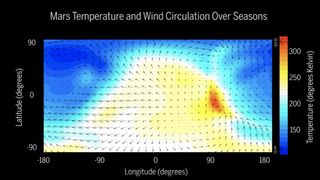A new global map of winds on Mars shows "ripple effects" from the extreme terrain below.
As the wind sails nearly 190 miles (300 kilometers) above the Red Planet's surface, researchers can see changes caused by the Martian landforms below, including mountains, canyons and basins. The same sort of thing happens on Earth, but the researchers found something unexpected about the effect on Mars.
"On Earth, we see the same kind of waves, but not at such high altitudes. That was the big surprise," study co-author Mehdi Benna, a planetary scientist at NASA and the University of Maryland, said in a statement.
Video: Mars Upper Atmosphere Winds Mapped
Related: NASA's InSight Mars Lander 'Hears' Martian Wind, a Cosmic First
The researchers suggested two explanations for why this might be happening. One is that Mars' atmosphere is much less dense than Earth's, so these "orthographic waves" might be able to move farther on the Red Planet, just as ripples travel farther in water than they do in molasses, Benna explained.
The second possible factor is that there is a bigger average altitude difference between peaks and valleys on Mars than there is on Earth, especially because many mountains on the Red Planet are twice as high as Mount Everest (which stands roughly 5.5 miles, or 9 km).
"The topography of Mars is driving this in a more pronounced way than it is on Earth," Benna said.
The researchers documented the global wind circulation patterns on Mars at 75 to 190 miles (120 to 300 km) above the surface, using local observations. It's the first time that scientists have created a global wind map of any planet — meaning that Mars was mapped even before Earth.
Related: Europe Launches 'Aeolus' Satellite on Mission to Map Earth's Winds
To accomplish this incredible feat, the researchers reprogrammed an instrument called the Natural Gas and Ion Mass Spectrometer (NGIMS) on the Mars Atmosphere and Volatile Evolution (MAVEN) orbiter to swing back and forth, rather than staying still.


When Benna first proposed this idea in 2016, the MAVEN team was concerned about the possible risks of changing the NGIMS in this way. But Benna and his colleagues checked with experts at manufacturer Lockheed Martin, who determined that swinging the instrument would pose no threat to the spacecraft.
"It's a clever reengineering in flight of how to operate the spacecraft and the instrument," Benna said. "And by doing both — the spacecraft doing something it was not designed to and the instrument doing something it was not designed to do — we made the wind measurements possible."
The team also made some other findings with the repurposed instrument. For one, they discovered that Mars' atmosphere has a stable circulation pattern from season to season. However, they also found that winds in the planet's upper atmosphere are more variable than expected, which means the winds change direction faster and more frequently. The team is still trying to figure out why this is.
With two years of data in hand, the team hopes to keep collecting new information while running more models to better understand the patterns of Martian winds.
A paper based on the research was published today (Dec. 12) in the journal Science.
Follow Elizabeth Howell on Twitter @howellspace. Follow us on Twitter @Spacedotcom and on Facebook.

Science - Latest - Google News
December 13, 2019 at 02:01AM
https://ift.tt/2qLXepv
1st Global Map of Martian Winds Reveals 'Ripple Effects' from Extreme Terrain - Space.com
Science - Latest - Google News
https://ift.tt/2Kb7H4e
Shoes Man Tutorial
Pos News Update
Meme Update
Korean Entertainment News
Japan News Update
Bagikan Berita Ini














0 Response to "1st Global Map of Martian Winds Reveals 'Ripple Effects' from Extreme Terrain - Space.com"
Post a Comment